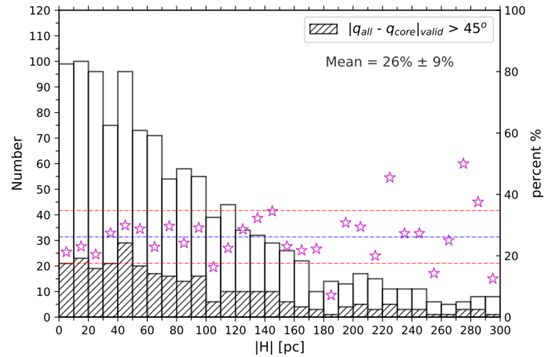Open clusters are ideal “laboratories” not only for star formation and evolution, but also as an important component of the Milky Way. The morphology of open clusters is a useful tool to study the dynamic evolution of open clusters. In addition, statistical analysis of cluster morphology helps us to understand the morphological evolution of open clusters.
PhD. Student HU Qingshun, Prof. Ali·Esamdin and Prof. ZHANG Yu from Xinjiang Astronomical Observatory (XAO) of the Chinese Academy of Sciences, investigated the morphological evolution of 1256 open clusters by combining the shapes of the sample clusters in the proper motion space with their morphology in the two-dimensional spherical Galactic coordinate system, based on a member catalog derived from Gaia Second Data Release as well as data from the literature.
They found that the dislocation (d) is related to the X-axis (pointing toward the Galactic center), Y-axis (pointing in the direction of Galactic rotation), and the Z-axis (log(|H|/pc)) that is positive toward the Galactic north pole (Figure1) when analyzing the dislocation of core and outer components. This finding underlines the important role of the dislocation of clusters in tracking the external environment of the Milky Way. In addition, NGC 752 seems to be possible in an early stage of expansion in the two-dimensional space and will become deformed along the direction perpendicular to the original stretching direction in the future if no other events interrupt (Figure2).
Moreover, these results also suggested that the severely distorted sample clusters in each group account for about 26%±9%. This possibly implies a uniform external environment in the range of |H| ≤ 300 pc if the sample completeness of each group is not taken into account (Figure3).
Figure 1. Correlations between the dislocation parameters and the special positions of sample clusters.

Figure 2. Spatial distribution of NGC752 and its velocity vectors.

Figure 3. Histogram of sample clusters with |H| ≤ 300pc and the effective dip angle difference greater than 45 degree.
Contact: HU Qingshun
Xinjiang Astronomical Observatory, Chinese Academy of Sciences
Email:huqingshun@xao.ac.cn
Web:https://doi.org/10.1051/0004-6361/202141460